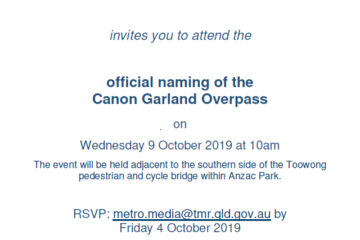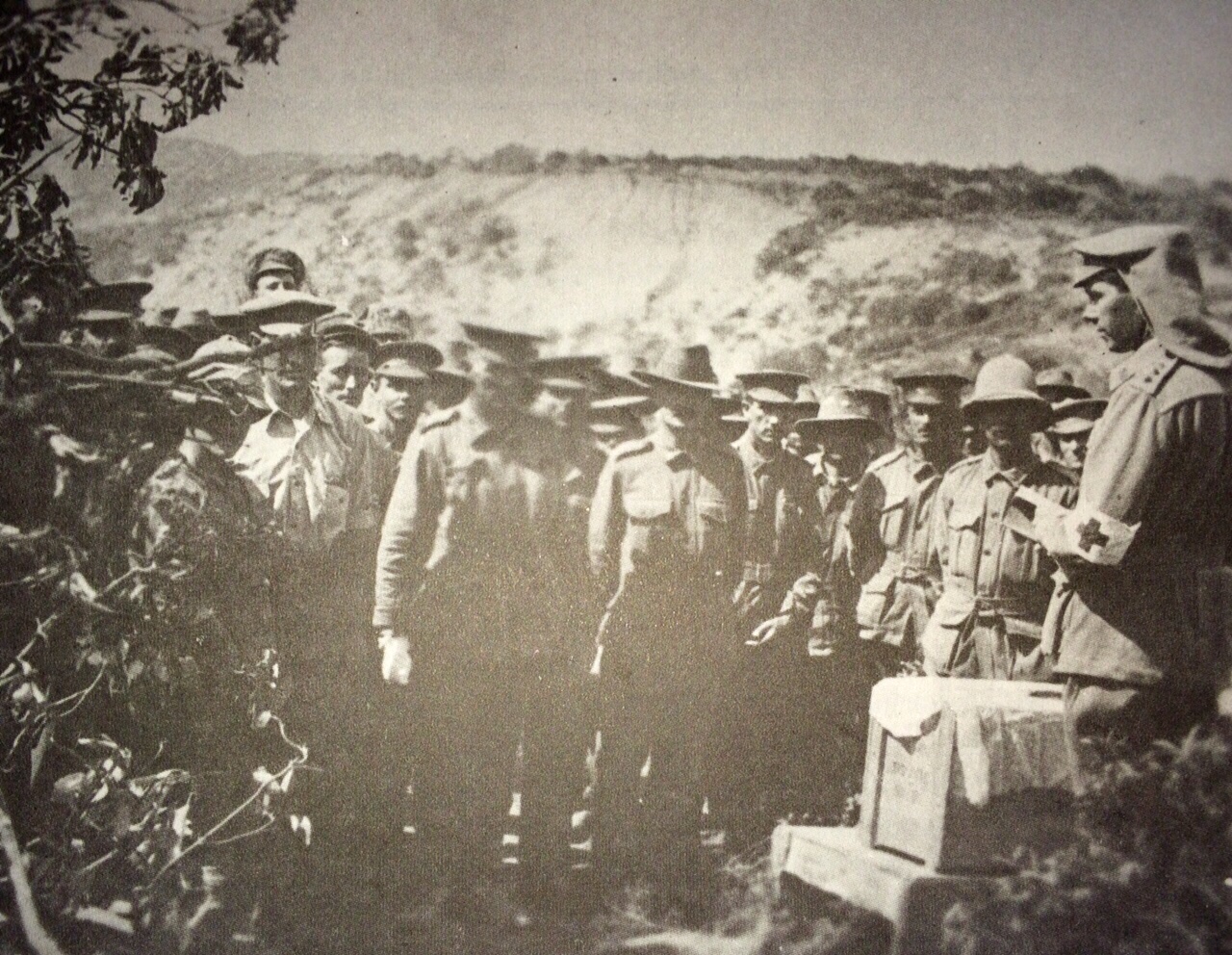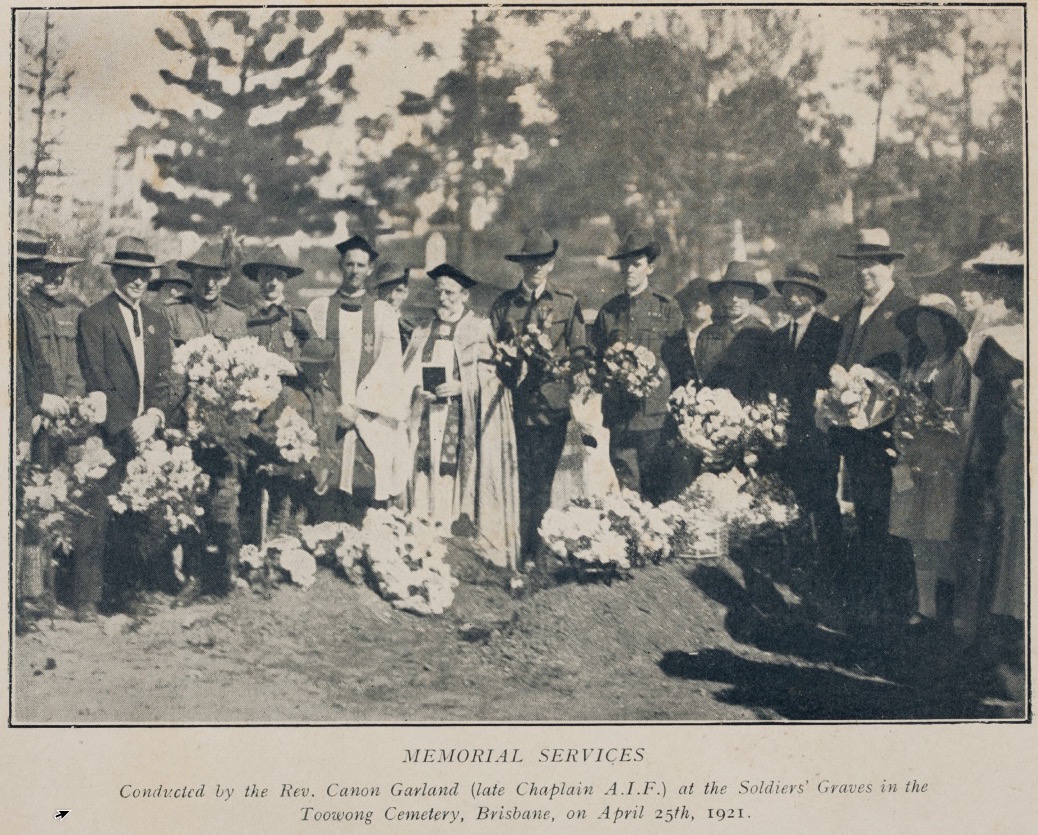Padre Maxwell’s sermon
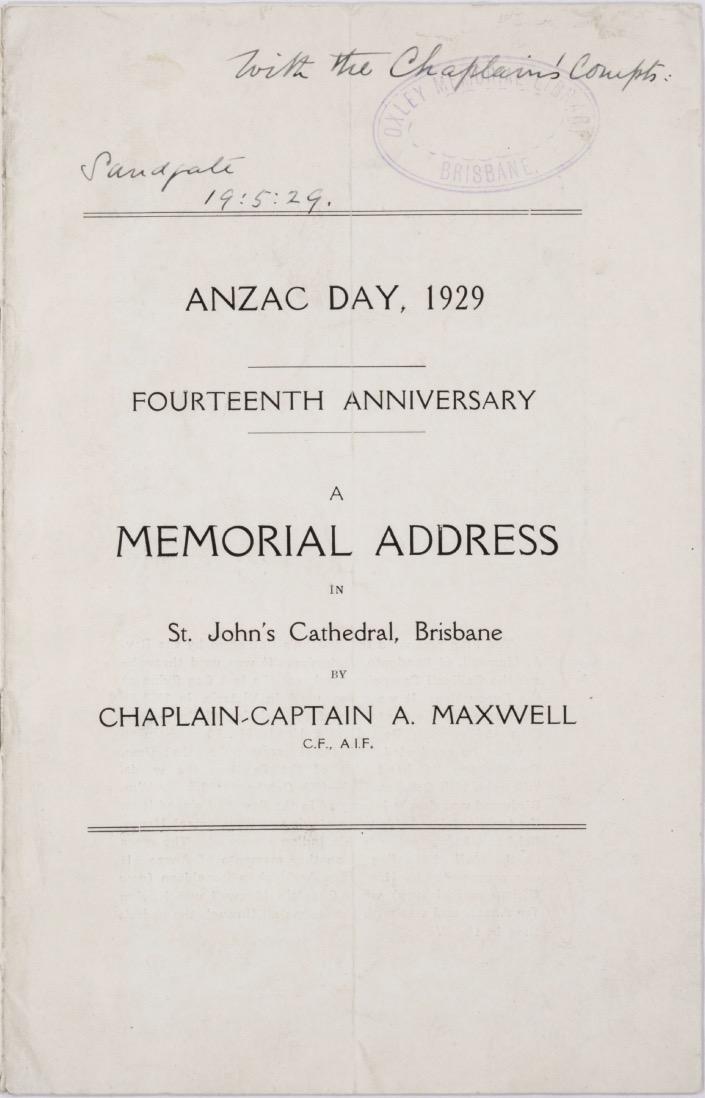
ABOVE: The cover of the pamphlet containing the text of the Reverend Alexander Maxwell’s Anzac Day sermon he delivered at Brisbane’s St John’s Cathedral at 11am on Thursday, 25 April 1929. This original document was among the “Hackett’s Scrapbooks” (Volume 3 — Queensland State Library, Item No. OM92463) of ANZAC Day-related original documents. The pamphlet is inscribed “With the Chaplain’s Compts: Sandgate 19:5:29”. At the time, Fr Maxwell was the Rector of Sandgate Anglican Parish.
ANZAC DAY — FOURTEENTH ANNIVERSARY, 1929.
St John’s Cathedral, Brisbane, 11am.
1. Cor. XV. 54: “Death is swallowed up in victory.”
“Today Australia kneels, and puts aside
All lesser cares — all lesser grief and pride;
And every heart keeps solemn tryst with thee
And with thy tragic graves — Gallipoli.”*
[ *AN EXCERPT FROM BRISBANE AUTHOR, EMILY HEMANS BULCOCK’S 1922 POEM, “IN MEMORIAM”. ]
Fellow Soldiers, Brother Anzacs.—
Once again we are gathered in our beautiful Cathedral on Anzac Day — the 14th anniversary of the day when some of you helped make Australia great among the nations.
We come here to worship God. To remember with reverence and pride our beloved comrades — gone west!
To express our heartfelt compassion for the many sick and wounded still with us and the many bereaved friends.
As one in the family of British Nations, we are called to realise our Imperial unity today in this solemn act of united worship.
From all the Altars of this great land and throughout our worldwide Empire, rise today the prayer and praise of millions.
Though sundered far, we are knit together in one communion and fellowship — in tenderest sympathy with the sorrowing — in prayer and praise and thanksgiving for our heroic and immortal dead, and for the great final Victory.
Who can measure the anxiety and anguish of those years of war?
I have fellow feelings for fathers, Mothers, Wives and other dear ones — for my two sons, a son-in-law, and brother were all in the fiery furnace of the war — myself, nearly three years — half-time with Australian Forces, the rest in British service as padre on the “Dunluce Castle”, and often ashore at Anzac, Helles and Suvla, carrying wounded to various hospitals in Egypt, Malta and England.
It is, therefore, with a full-heart memory of that experience and as soul to soul, that I speak to you, my Brothers, this morning.
In the Gallipoli campaign alone over 5,000 sick and wounded passed through the Hospital ship of which I was the only Chaplain.
One one trip (after Lone Pine), we buried at sea 57 men between Anzac and Malta, in three days.
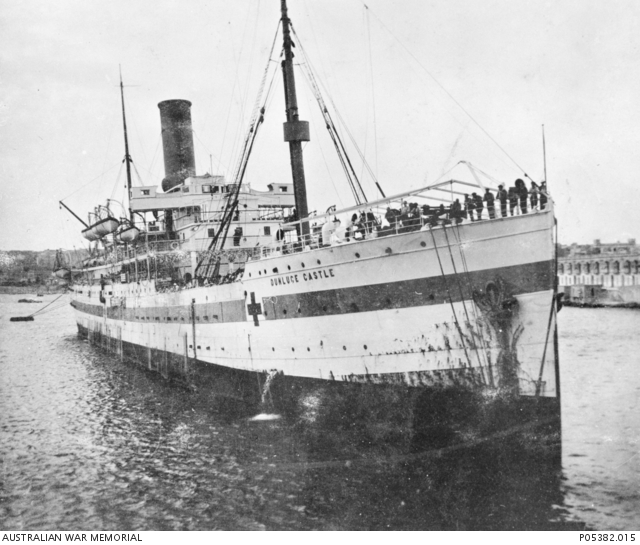
ABOVE: His Majesty’s Australian Troopship, “Dunluce Castle”, in Malta Harbour in 1915. AWM Image No, P05382.015. Padre Maxwell served on this vessel as it brought the wounded to Mudros from The Dardanelles Front.
The first thing that shone out in all that sad and soul-stirring experience was the love of the Digger for his “cobber” (or mate).
A thing most beautiful to see.
The next thing was the wonderful devotion of the Nurses and Doctors to their patients, and the unbounded gratitude of the men.
Also the marvellous generosity of the Red Cross Societies in supplying comforts.
The men themselves showed such splendid courage when wounded and in pain or dying, that one felt proud to be with them and to belong to the same race.
It was a privilege to minister to such men — such manly men!
“Stern in onset or defence,
Terrible in their confidence!”*
[ *AN EXTRACT FROM “OCTOBER AND OTHER POEMS WITH OCCASIONAL VERSES
ON THE WAR” BY ROBERT BRIDGES, LONDON: WILLIAM HEINEMANN, 1920. ]
Could there have been a finer spirit shown than was displayed on that April morning 14 years ago when those gallant sons of Australia and New Zealand were towed Ashore in crowded boatloads from the warships and, at dawn of day, flung themselves on the Anzac beaches and stormed the heights in the teeth of a murderous fire?
The fell as fast as they landed, but more and more came pouring on shore behind them, until at last the heights were won.
All the world said it was an impossible task, and so it was to all but such men as Australia mourns today — the brightest and best of her sons.
It was no wonder that a British General said to me: “If they had all been like these Anzac men, Padre, we should have got through to Constantinople long ago!”
However, the dear old flag waves on Gallipoli today, and our comrades sleep in peace.
But the men whose we honour today are most surely living somewhere now, although their heroic dust is mingled with the clay on many battlefields both East and West.
“Somewhere thou livest and hast need of Him;
Somewhere thy soul sees higher heights to climb;
And somewhere still, there may be valleys dim
That thou must pass to reach the heights sublime.
“Then all the more, because thou can’st not hear
Poor human words of blessing, will I pray,
O‚ true, brave Anzac heart, God bless thee, whereso’er
In this wide universe thou art today.”*
[ *A SLIGHTLY ADAPTED EXTRACT FROM “THE GOSPEL OF THE HEREAFTER” BY JOHN PATERSON SMYTH, RECTOR OF ST GEORGE’S CHURCH, MONTREAL (LATE PROFESSOR OF PASTORAL THEOLOGY, UNIVERSITY OF DUBLIN). NEW YORK: FLEMING H. REVELL COMPANY, 1910. ]
The highest courage is often that which shrinks from death in every quivering fibre of the thrilling life and yet, for truth, for love, for God, and freedom — dares to die — so was it with the Anzac men.
What kind of discipline was theirs, who dared to do and die so heroically?
It was the discipline of great-hearted, free men — born in the wide, generous land.
Of men who took a broad, heroic view of their objective and needed no encouragement to pour all that was in them to accomplish it.
No celebration of Anzac Day is complete without the commemoration of those who fell.
We believe, with Doctor Davidson [ Randall Thomas Davidson ], the late Archbishop of Canterbury, and Cardinal Mercier [ Désiré-Félicien-François-Joseph Mercier ], that it cannot go ill in any world with those who laid down their lives for their friends in this world.
We do not claim for these men, our comrades, that they were Saints, any more than we claim that for ourselves.
What we do claim for them is that they were MEN, and men of whom any country might be proud, because, in the hour of fiery trial, they counted not the cost, but DID THEIR DUTY.
They are men of whom not only Australia and New Zealand are proud, but the whole civilised world has enshrined in loving memory as some of the worthiest heroes in the greatest war in history.
At the landing, no less than 4,500 Anzacs fell in two days.
Many of them recovered quickly from their wounds and landed a second and even a third time upon the Peninsula, to carry on in the great fight for the world’s freedom.
Ah! Those glorious soldier-martyrs, what can we say too good of them?
They did not go to gamble with death for 6/- [ six shillings, or equivalent to 60 cents ], as some said.
It was love of home and country, of freedom and honour that called them across those 12,000 miles of land and sea.
The 25th of April 1915, was a great day for Australia.
What was done by our brave lads on that day will not only inspire to noble deeds the present generation, but generations yet unborn.
The memory of our 60,000 is a sacred trust to the nation as well as the care of their dependents.
Anzac Square, in the heart of our city, is soon to contain a fitting memorial of Queensland’s Anzacs who “went West”.
But all the Anzacs are not dead. Thank God, thousands have come back and are with us now.
Above all, and best of all, the Anzac Spirit is not dead.
That dauntless spirit is a rich heritage which will inspire this young nation for all time.
When teaching numbers of children in the State Schools, I have often seen their faces light up with honest pride at the name of Anzac.
It seems most appropriate that Anzac Day and its celebrations should come as it does in the midst of the Easter Festival, because, and today we must not forget it, many hearts are still lonely and sore and sorrowful for those dear, heroic ones who did not return, who made the Supreme Sacrifice.
Easter speaks to us all of Hope and Reunion.
So, on this Anzac Day, in this wonderful and beautiful Service, and in the power of the easter Festival, we realise that on the Cross and through the Cross, it is not Christ and His brothers die, but that death itself dies; and so —
“Death is swallowed up in Victory.”
We owe to those memories we honour today to show ourselves worthy of what has been done for us.
These brave young men of our helped strenuously to settle the mighty question — whether tyranny or freedom — might or right should rule the world.
Australians love to “Play the Game”, and they died for their principles of justice and fair play — but their “death was swallowed up in Victory”.
The victory of freedom.
Wounds, pain, death — are horrible in themselves, but glorified by the motive for which they were incurred.
The price was great, but the prize of National freedom and honour is greater.
Even with all its costs of pain and death and sorrow, Anzac Day is a most glorious day for Australia, our sister Dominions and the whole world.
It is a day which reflects the light of Easter. It is bright with a supernatural light and filled with a supernatural power.
Let us strive, then, to be worthy of living in such a day as the present.
During the war a great statesman quoted the stirring lines from the poet Wordsworth:—
“Bliss was it in that dawn to be alive,
But to be young, was very heaven.”*
[ *AN EXTRACT FROM “THE EXCURSION: BEING A PORTION OF THE RECLUSE, A POEM” BY WILLIAM WORDSWORTH. ]
The Excursion: Being a portion of The Recluse, a poem
And wear does it mean to be worthy of so great an event?
Here in Australia (especially in Queensland) we are not children of the night, but of the day; we are not pessimists, but born optimists.
We are born in the sunshine — we believe “good will be the final goal of every ill”; we are children of the Resurrection: We believe that, though we have lost sight for awhile of our darling Anzac boys — those great-hearted, unselfish, generous boys — that they are still somewhere in the sunshine of God’s Presence.
We are children of the light and of the day. Death has no terrors for us as it had no terrors for them.
One brave soldier-martyr wrote in his note book the following lines found on him after he fell:—
“We do not fight this war from greed of grain,
We strive that others after may be free;
And while our bodies brave the chance of pain,
With holy prayers we trust our souls to Thee.”
The Victory that this Easter Festival commemorates is the Victory over Death — “Death is swallowed up in Victory.”
“They died, and yet in memory shall they live,
That we may know the worth of sacrifice —
Know that their death in freedom’s cause
Stands as a beacon-light to point the way
To paths of Peace.
“So let us think, and as our thoughts arise
We nearer bring the souls of those who died;
And listening, we shall hear the spirit voice
Of Anzac’s dead.”
I have brought here today two precious memorials — this Flag and this Cross.
This first is only a flag, the Union Jack; but it is of the greatest historic interest to Australia, and especially to Queensland.

ABOVE: “The Brisbane Courier” covered Padre Maxwell’s presentation of his Gallipoli Evacuation Flag to St John’s Cathedral on Anzac Day 1929. An article, using this particular image, appeared in the following day’s edition on page 18. This version of the same text, however, appeared on page 2 of the pamphlet containing the full text of the sermon, that was published and circulated some weeks later. This image appeared in “Hackett’s Scrapbooks” (Volume 3 — Queensland State Library, Item No. OM92463) of ANZAC Day-related original documents.
It was used in 1903 in Victoria to commemorate the centenary of the first hoisting go the British flag in that sister State.
On the 16th October 1803, the officers of HMS “Calcutta” hoisted the British flag where now stands the town of Sorrento, near Port Phillip Heads.
Being officially invited to conduct the ceremony of the 100 years’ commemoration, this is the flag that I used on that occasion.
On the top left corner of the flag is worked the inscription: “Victoria, 16th October 1803-16th October 1903”.
Then when the Great War came, I took this flag to the Front, and had to with me on shore at Anzac on the last day of the Evacuation, about 1.30, 19th December 1915.
Returning from Hell’s Spit Cemetery, the Turkish gun, “Beachy Bill”, fired three times, but missed both the flag and its bearer.
Being invited to meet Field-Marshal Sir William Birdwood [ William Riddell Birdwood ] at Government House, Brisbane, just before going to his present Indian command, I took this flag with me, and the Field-Marshal signed it in the top right-hand corner, as the last flag to fly on Anzac on the day of the Evacuation.
This is briefly the story of the flag which to-day I am presenting to this Cathedral.
A flag is only a bit of bunting, but the three-crossed, three-coloured flag, called the “Union Jack”, is symbolic of the three great principles of Honour, Truth and Justice, for which our Empire fought.
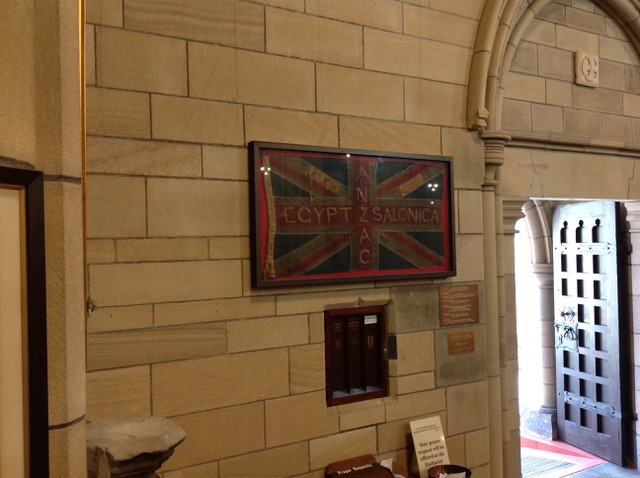
ABOVE: The Gallipoli Evacuation-Victorian Centennial of European Settlement Commemoration Flag, located on the Southern Transept (western wall) of Brisbane’s St John’s Cathedral. Photo courtesy of Peter Collins.
Through the ages it has come down to us the symbol of these great principle.
It is a sacred heritage we have been upholding as our father did before us.
Our National Flag has been dyed a deeper red than this over and over again with the blood of our bravest and best.
Our rulers remembered that, when they were tempted by the enemy to act dishonestly towards the little nation of Belgium and to break a Treaty.
May you all true Britons look up at the Flag and remember the cost of the Flag when we are tempted to lie to one another or to cheat one another or to act dishonourably.
Let us think of the blood of our brave brothers upon the flag.
It cries to us from our countless dead in land and sea, and the cry is echoing still around the world:—
“I died fighting for the flag — keep its honour clean — don’t let my blood be spilt in vain.”
The Cross on the flagstaff is the one consecrated by Archbishop Donaldson when I was leaving for the Front.
It was used for Sacramental Services at Anzac and with the troops all through my time in the war, and has now come to rest in this noble Cathedral which his Lordship of Salisbury loved so well.
This Anzac Flag and Cross are now humbly offered and presented to St. John’s Cathedral, Brisbane, for use and preservation and in Sacred Memory of our Beloved Anzacs who gave their lives in all parts of the world in the cause of righteousness.
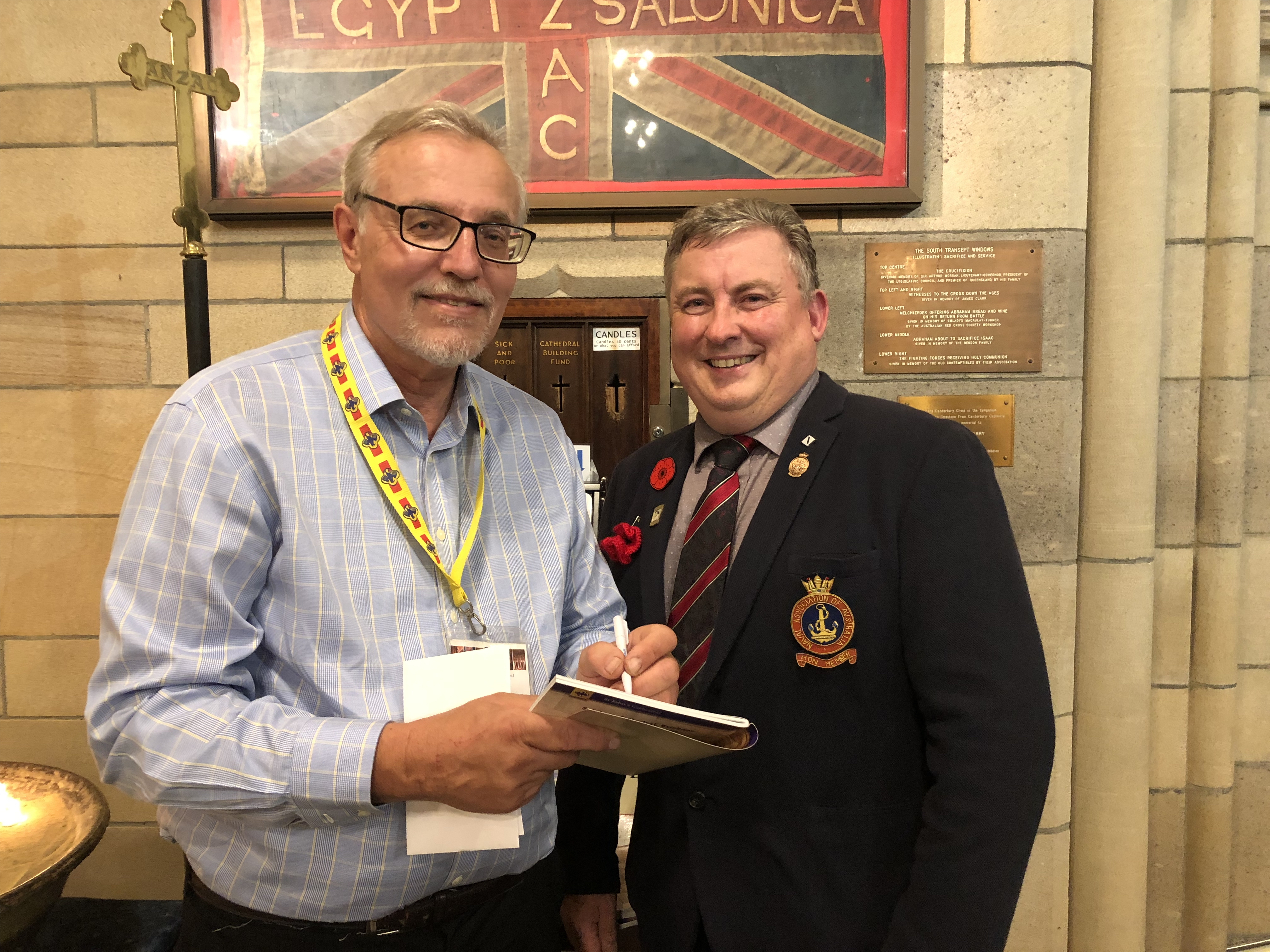
ABOVE: Author, Denzil Scrivens (left) signs a copy of “St John’s Cathedral, Brisbane, and the Anzac Legend” for the book’s editor, Peter Collins, at the official launch at St John’s Cathedral on 19 December 2018. Above is the Gallipoli Evacuation Flag that Padre Maxwell presented on Anzac Day 1929. For coverage of the book launch, refer to Ian Eckersley’s comprehensive report in the Anglican Church Southern Queensland’s “anglican focus” online resource. Photo courtesy of Michelle Collins.
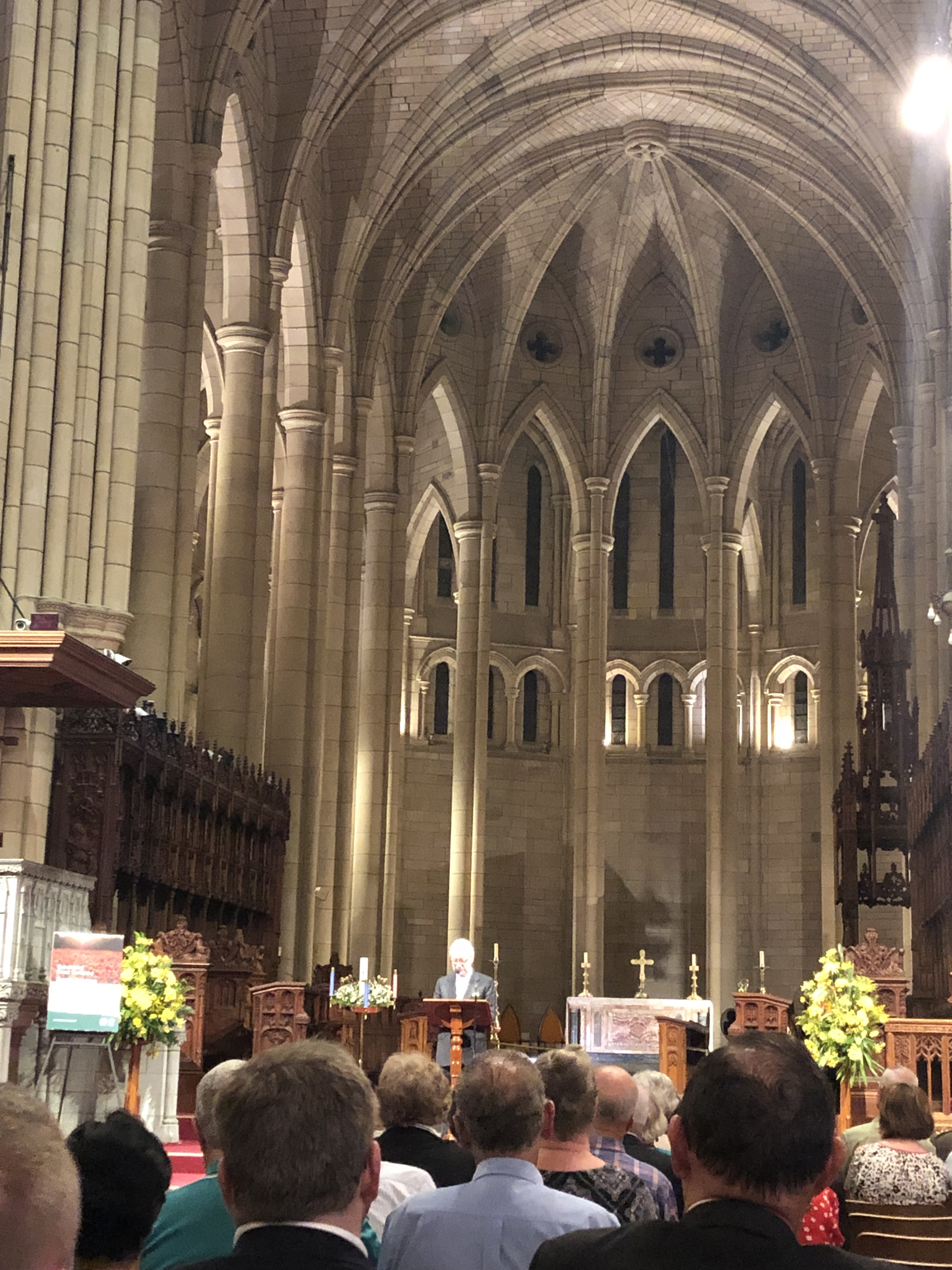
ABOVE: The Queensland Governor, His Excellency the Honourable Paul de Jersey AC, addresses the audience in St John’s Cathedral at the launch of the book. Photo courtesy of Peter Collins.
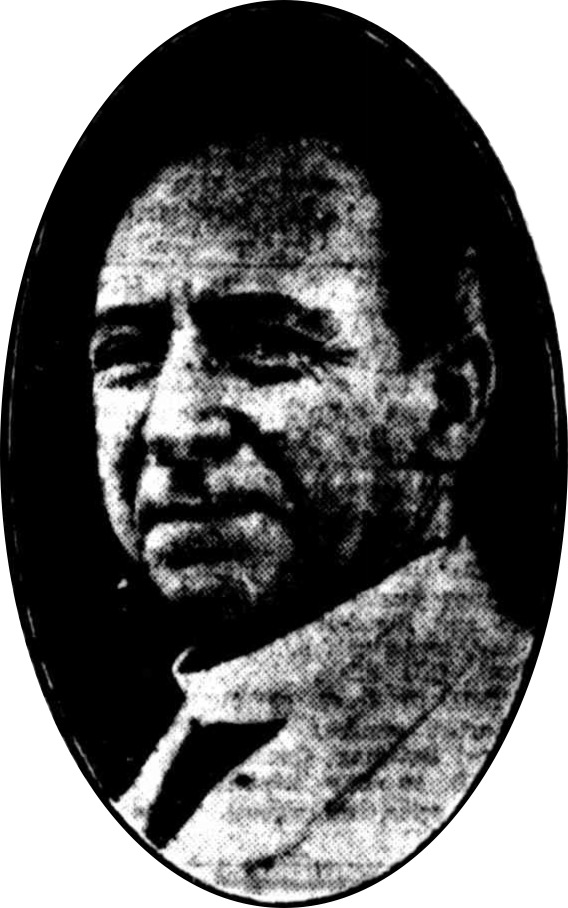
ABOVE: The Reverend Alexander Maxwell’s photo appeared in an article in 23 January 1926 edition of “The Brisbane Courier” (page 14). In the piece, the Rector of Cleveland announced his intention to retire from active ministry.
AFTER 47 YEARS.
REV. A. MAXWELL RETIRES.
A NOTABLE LIFE.
NEARLY half a century ago — in 1879 to be accurate — the Rev. A. Maxwell [ Alexander Maxwell ] became a clergyman of the Church of England.
On Sunday, January 3, he preached his farewell sermon in St Paul’s, Cleveland.
His working life has been one of fullness and achievement; and none of the 47 years which he gave to the Church has been lean.
Heavy rain prevented many from coming who otherwise would have been present to hear Mr. Maxwell’s farewell sermon.
At its conclusion the congregation left the church and went to the parish hall, where presentations were made to Mr. Maxwell and also to Mrs. Maxwell [ Elizabeth Harriet Maxwell, neé Waldrond ].
The People’s Warden, Mr. A.C. Morgan [ Arthur Clinton Morgan ], was chief spokesman at this assemblage.
He handed to Mr. Maxwell an illuminated address framed in oak and a wallet well-filled with bank notes.
The address told all who read it of the long and faithful services of Mr. Maxwell, and of the enduring affection of his parishioners.
A Common Prayer and a hymn book, both bound in green morocco, were presented to Mrs. Maxwell by Mr. Harley [ Edgar Horace Harley ], who wished her every success.
Mr. Maxwell responded both for himself and on behalf of his wife.
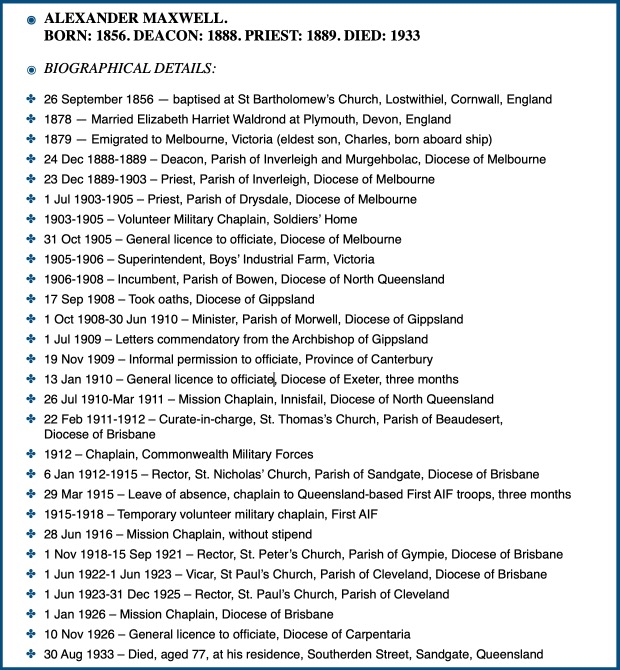
ABOVE: Fr Alexander Maxwell’s career overview. On 8 February 1915, at the age of 59, he activated his chaplaincy status and enlisted in the First AIF, and was designated “Chaplain 4th Class” with the honorary rank of Captain. He sailed from Brisbane aboard His Majesty’s Australian Troopship, A15, “Star of England” on 8 April 1915. Upon arrival at the Front he saw service in The Dardanelles Campaign.

ABOVE: The Reverend Alexander Maxwell’s family tree, showing his six children. His eldest son, Dr Charles Maxwell, served as a medical officer in the First AIF. Padre Maxwell’s third son, Waldron Bell Maxwell, served in the 24th Battalion, 15th Reinforcements. Genealogical research courtesy of Peter Collins.
INTERESTING LIFE.
Few members of the clergy have had such an interesting life as Mr. Maxwell, who was born in Cornwall in 1856.
He lived chiefly in Devonshire until coming to Australia in 1879, the year in which he became a clergyman, his licence to preach having been given by Bishop Moorhouse [ James Moorhouse ], of Melbourne.
Mr. Maxwell served with honour many years later in the Great War, being invalided from service in April 1917.
Mr. Maxwell’s first parish was at Sorrento, Victoria, and 30 years of his Church life were spent in the Melbourne Diocese.
In a letter of appreciation, dated July 12, 1906, Archdeacon Hindley [ William George Hindley ], of Melbourne, spoke in warm terms of the work which Mr. Maxwell had performed in the districts and parishes of Modewarre, Sorrento, Doncaster, Inverleigh and Drysdale: “He has been, and is, a devoted and self-denying clergyman, and, without an exception, in every parish he has left behind substantial evidence of his devotion. Churches, schools, and vicarages have been built or restored, debts have been paid, and conditions of useful work vastly improved for his successors.”
After being in Queensland for a term, he returned to Victoria, which State he left later to take a 12 months’ trip to England.
When he returned to Australia he went to Innisfail. Then he left for Morwell (Victoria).
Beaudesert was his next charge, and then Sandgate.
Everywhere his departure was viewed with deep regret, and his parishioners greatly appreciated the work which he did, not only in attending to the spiritual welfare of the people, but also in placing, by his sound judgment and systematic organisation, the finances of the Church upon a satisfactory basis.
Mention was also made by his Sandgate parishioners of his devotion to duty in having enlisted as a chaplain of the Imperial Forces, and of the good work which he had done both on transports and on hospital ships.
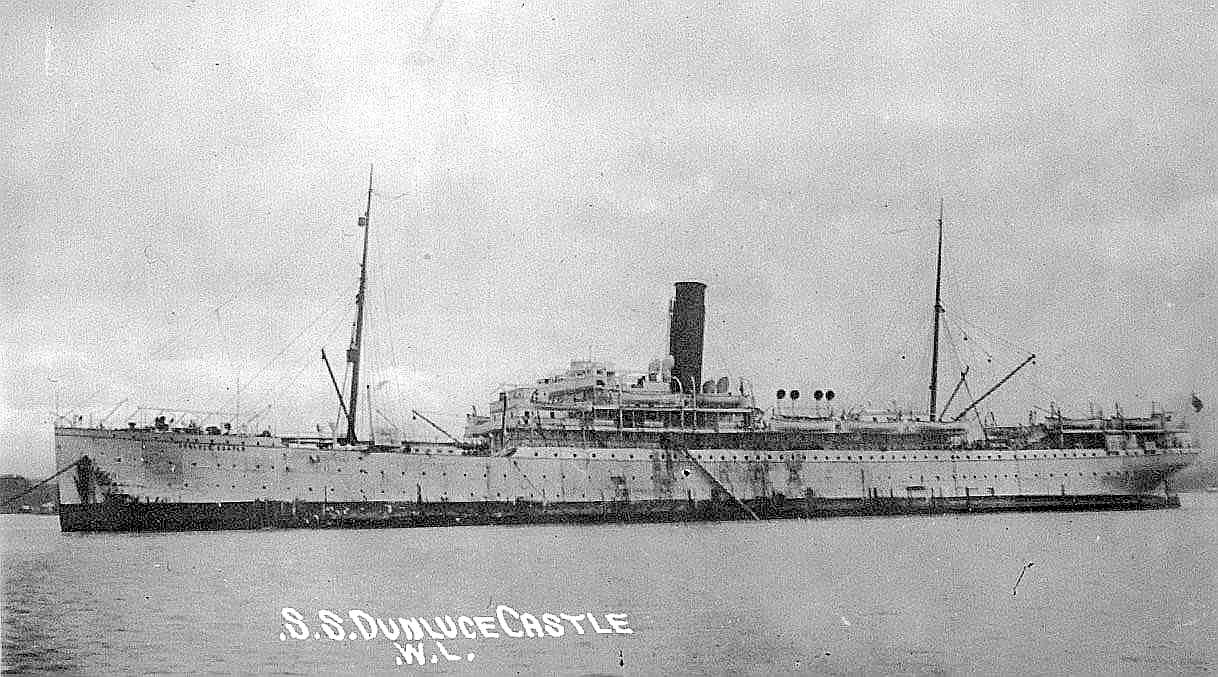
ABOVE: The Steam Ship “Dunluce Castle” was built in 1904 at Belfast, Ireland, by Harland & Wolff Limited. After its Great War service as a troopship/hospital ship, the 8,124 gross-ton, steel, twin-screw steamer worked the Australian coastline for the Union-Castle Mail Steam Ship Company Limited. This image is from the “Passengers in History 1836” website, created by the South Australian Maritime Museum. File reference No. 8443.
LIGHT HORSE CHAPLAIN.
At the outbreak of war the Rev. Mr. Maxwell left for Egypt as chaplain with the Light Horse, and later he was chaplain in the Imperial Service.
He was successively on the hospital ships, Delta, and Dunluce Castle, with invalided troops from Egypt, Hellas, Anzac, and Suvla Bay to the base hospitals in Egypt, Malta, and England. Following the evacuation of Gallipoli, he was present at the removal of part of the Serbian Army to the French settlements in North Africa.

ABOVE: His Majesty’s Hospital Ship Delta. AWM Image No. J05782.
After coming back to this State, Mr. Maxwell went into camp at Enoggera, but left soon afterwards for France. He did not arrive there, as he contracted pneumonia.
He was invalided back to Queensland, and later went to Gympie where he remained three years.
In that town also he won golden opinions, and was largely instrumental in securing the erection of the handsome Soldiers’ Memorial.
Cleveland, where he spent the closing years of his Church life, counts itself extremely fortunate through his advent.
The vicarage has become a rectorship, and many improvements have been made to the churches in all parts of this wide-flung parish.
A new hall, too, has been built at Russell Island, and a church debt of £150 has been liquidated.
LAND GIFTS.
Mr. Maxwell also secured for the Church substantial areas of land on Russell Island, the gift of Mr. Fred Willes [ Frederick John Shippen Willes ]; on Macleay Island, the gift of Mr. R.W. Weedon; at Redland Bay, the gift of Mr. Fielding [ William Fielding ]; and at Birkdale, the gift of Mrs. W. Ridler [ William Henry Ridler ].
It is Mr. Maxwell’s intention to live at Sandgate, where he has many friends, and where he is still lovingly remembered by all sections of the community.
His place at Cleveland has been taken by the Rev. C.H. Massey [ Cyril Horswill Massey ], of Murgon.
— from page 14 of “The Brisbane Courier” of 23 January 1926.
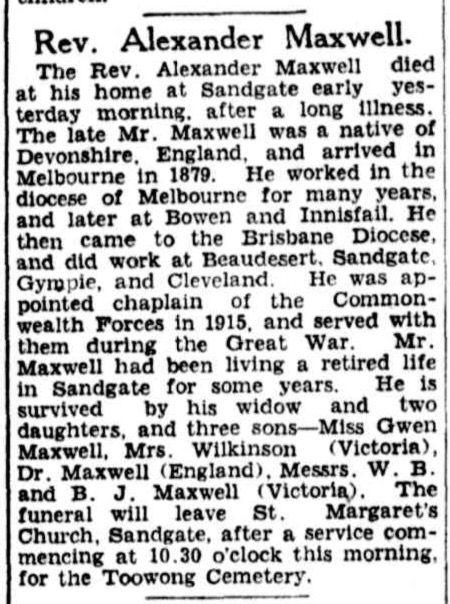
ABOVE: This obituary for the Reverend Alexander Maxwell appeared in “The Courier-Mail” in its 31 August 1933 edition (page 15).
